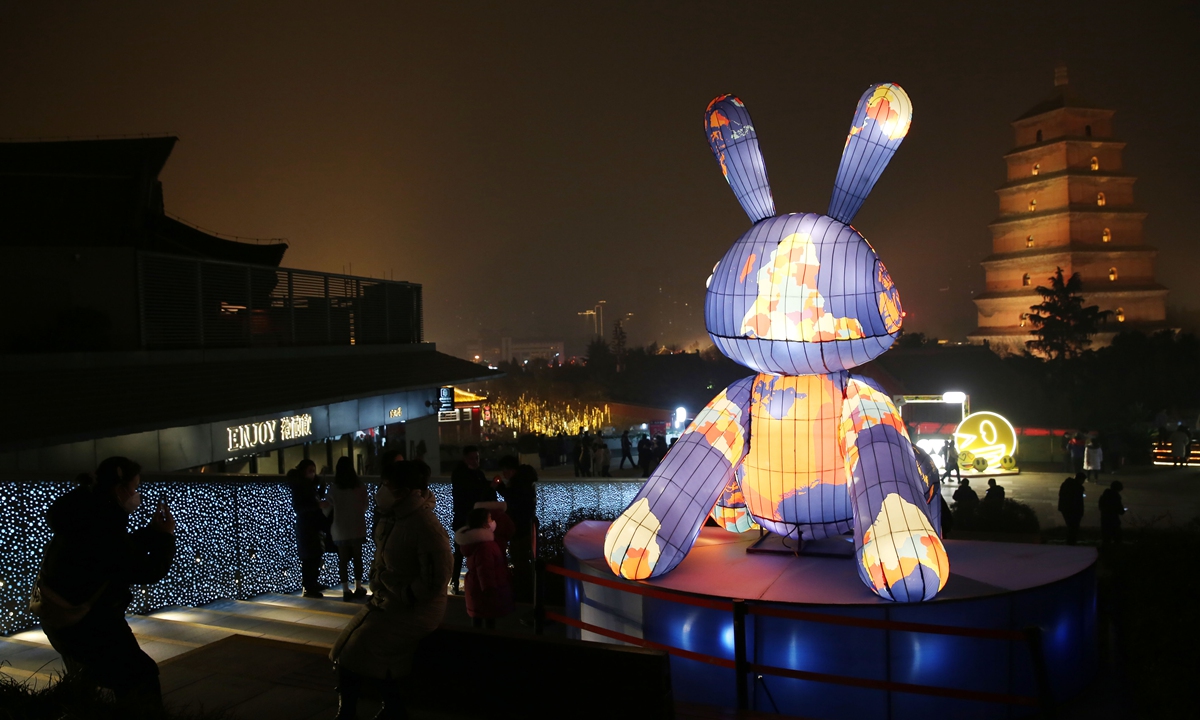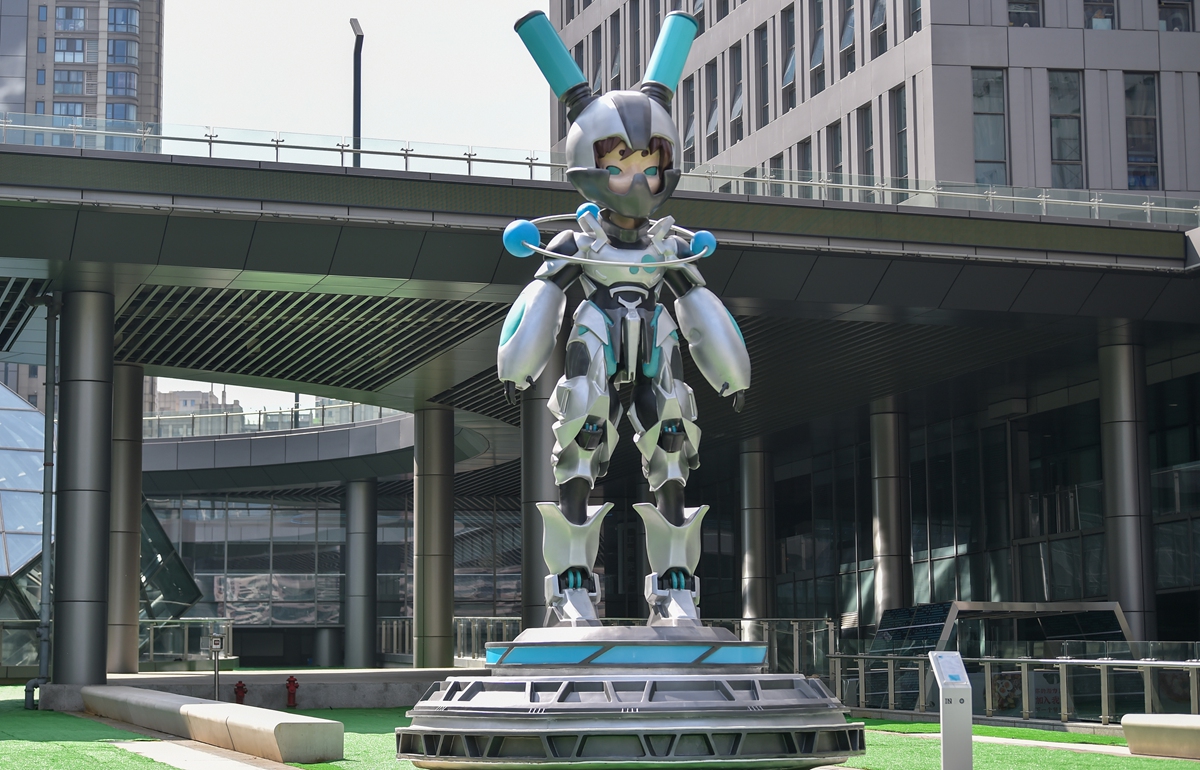
A rabbit-shaped lantern in Xi'an, Shaanxi Province Photo: VCG
Editor's Note:
As the Year of the Rabbit approaches, the images of rabbits are appearing everywhere. In Chinese culture, the rabbit is not only a symbol of good luck, but also connected to longevity and fertility. Associated with the moon, the rabbit has appeared in numerous legends and classic literature works. In this three-article series, the Global Times explores why Chinese people love this auspicious symbol and how it is staying relevant today. This is the third and final piece of the series.
An eye-catching giant black rabbit covered in mysterious graffiti suddenly pops into view on an LED screen overlooking a crowded street in Shanghai's Hongyi Plaza. The rabbit, called Heart Hunter, captures the attention of passersby, who stop and take photos of it.
The large outdoor digital artwork was created by young Chinese artist Zhang Fan. In Zhang's eyes, the bunny represents many of today's young people living in urban areas as the rabbit is traditionally connected to romantic love while also seen as timid, alert, adorable and rarely aggressive.
Because of the rabbit's long use as a traditional symbol and its new modern connotations, Chinese artists have been more than happy to design fresh versions of the auspicious animal, especially when the Year of the Rabbit approaches.
In recent years, some Chinese artists have taken aim at the latest trends and advances, using digital technology to give their bunny-themed artworks a futuristic feel. Many of these creative works have become huge hits among the public.
Fei Jun, a professor at the Central Academy of Fine Arts and an expert in the digitization of cultural relics and museums, told the Global Times on Wednesday that the high popularity of the rabbit in different cultural creations mainly comes down to the unique nature of the rabbit, which is seen as gentle and tame without any aggressiveness.
"It can heal your heart. You can say that 'rabbit' is another name for 'cuteness.'"
Entering the digital ageClicking a button on a webpage opens a box, revealing a bunny wearing a random selection of clothing such as a dress, shirt or glasses standing in a garden or on a street. With this one click, some lucky netizen has become the sole owner of a unique "Miss Rabbit" non-fungible token.
The
Miss Rabbit digital art collection created by Chinese artist Li Na in June 2022 contains more than 10 million images of bunnies wearing a variety of costumes and ornaments amid different backgrounds. According to a report from china.com, Li merges the rabbit and the human world to promote the concept of environmental protection.
Counting on adorable bunnies' ability to heal the human heart, some Chinese artists also use the rabbit to narrate human's stories in their digital artworks.
Koorabbee, a digital art collection, is one such example.
Koorabbee, whose name means "cool rabbit," are elf-like rabbits with exceptional long ears who pursue their own personal attitudes toward life. They are meant to represent the inner feelings and life status of contemporary people, and each Koorabbee tells its own story, the collection's creator explained in a post on Sina Weibo.
Fei noted that as a symbol of vitality, diligence and agility, the Chinese zodiac animal has been loved by people since ancient times so it is deeply rooted in the collective culture of the nation.
"Ahead of the upcoming Year of the Rabbit, a lot of cute rabbit memes have started appearing on Chinese social media. They are used by people across very different ages," Fei said.
He added that people living in today's fast-paced society seek emotional comfort, and the rabbit's nature can help relieve people's anxiety and pressure. This may be one reason why the rabbit image is so popular among Chinese consumers and why so many artists draw upon it for inspirations.

A "robot rabbit" towers over a Metaverse-themed commercial street in Nanjing, Jiangsu Province. Photo: VCG
New horizonsIn the future, the number and types of digital artworks are sure to grow and, as one of the favored symbols in Chinese culture, the rabbit is sure to stake out territory in the digital realm and the Metaverse, several artists told the Global Times.
With the development of cutting-edge technology, more exquisite digital artworks like Tu Yuan Yuan, the mascot for CCTV's 2023 Chinese New Year Gala, are guaranteed to flood the market during the Year of the Rabbit, creating even more interesting interactions with Chinese consumers, Fei said.
However, designer Yan Mengya told the Global Times that the rabbit has always been a popular icon in "China chic" products and, while the zodiac year is sure to give it a boost, its popularity will not be limited to 2023.
"I know a fellow designer who launched a line just about the rabbit. She used the animal related Chinese saying dongrutuotu, meaning 'bubbly like a rabbit,' for her sports head ban."
"Of course, in this Year of the Rabbit, China chic designs are going to increase, but the reason designers like the icon is mostly because they feel its strong cultural connections. We all share Chinese culture, so the rabbit is an icon of our cultural consensus," Yan noted.
With the creativity of Chinese artists and its auspicious connections, both past and present, the image of the rabbit is sure to continue to evolve and be refined, acting as an ambassador to spread Chinese zodiac culture over the horizon to other parts in the world.





